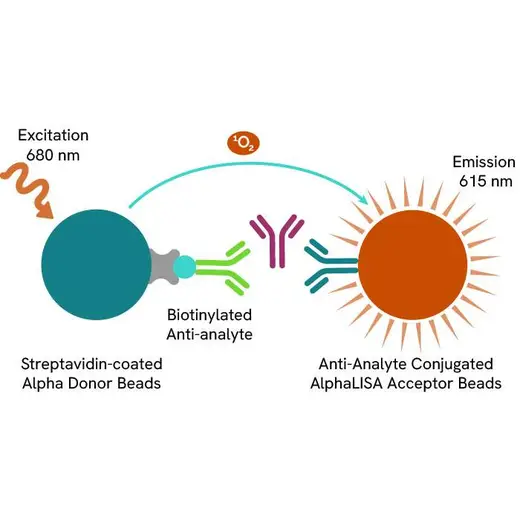
AlphaLISA Human HLA-C Detection Kit, 500 Assay Points


 View All
View All
AlphaLISA Human HLA-C Detection Kit, 500 Assay Points














The AlphaLISA™ immunoassay kit for human HLA-C enables the quantitative determination of human MHC class I antigen C (HLA-C) in buffered solution, cell culture media, and cell lysates using a homogeneous AlphaLISA assay (no wash steps).
For research use only. Not for use in diagnostic procedures. All products to be used in accordance with applicable laws and regulations including without limitation, consumption and disposal requirements under European REACH regulations (EC 1907/2006).
| Feature | Specification |
|---|---|
| Application | Protein Quantification |
| Dynamic Range | 56 - 300,000 pg/mL |
| Limit of Detection | 56 pg/mL |
| Limit of Quantification | 193 pg/mL |
| Sample Volume | 5 µL |
The AlphaLISA™ immunoassay kit for human HLA-C enables the quantitative determination of human MHC class I antigen C (HLA-C) in buffered solution, cell culture media, and cell lysates using a homogeneous AlphaLISA assay (no wash steps).
For research use only. Not for use in diagnostic procedures. All products to be used in accordance with applicable laws and regulations including without limitation, consumption and disposal requirements under European REACH regulations (EC 1907/2006).







AlphaLISA Human HLA-C Detection Kit, 500 Assay Points







AlphaLISA Human HLA-C Detection Kit, 500 Assay Points







Product information
Overview
Formats:
- Our 100 assay point kit allows you to run 100 wells in 96-well format, using a 100 µL reaction volume (10 µL of sample).
- Our 500 assay point kit allows you to run 500 wells in 96-well or 384-well format, using a 50 µL reaction volume (5 µL of sample).
- Our 5,000 assay point kit allows you to run 5,000 wells in 96-well or 384-well format, using a 50 µL reaction volume (5 µL of sample).
Features:
- No-wash steps, no separation steps
- ELISA alternative technology
- Sensitive detection
- Broad sample compatibility
- Small sample volume
- Results in less than 3 hours
- Half the time of an ELISA assay
AlphaLISA technology allows the detection of molecules of interest in buffer, cell culture media, serum and plasma in a highly sensitive, quantitative, reproducible and user-friendly mode. In an AlphaLISA assay, a Biotinylated Anti-Analyte Antibody binds to the Streptavidin-coated Alpha Donor beads, while another Anti-Analyte Antibody is conjugated to AlphaLISA Acceptor beads. In the presence of the analyte, the beads come into close proximity. The excitation of the Donor beads provokes the release of singlet oxygen molecules that triggers a cascade of energy transfer in the Acceptor beads, resulting in a sharp peak of light emission at 615 nm.
HLA-C, also known as MHC class I antigen C, official full name as major histocompatibility complex, class I, C, is a protein that in humans is encoded by the HLA-C gene. HLA-C is a heterodimer consisting of a heavy chain and a light chain (β-2 microglobulin). The heavy chain is approximately 45 kDa and anchored in the membrane. HLA-C has a very specialized role in cell recognition by natural killer cells (NK cells) and cytotoxic T-cell. HLA-C binds to killer cell immunoglobulin like receptors to regulate NK cell cytolysis activities. Recently, HLA-C has been involved in immune response to HIV-1. This kit has been designed for the detection of Human HLA-C in cell lysate and cell culture media.
Specifications
| Application |
Protein Quantification
|
|---|---|
| Automation Compatible |
Yes
|
| Brand |
AlphaLISA
|
| Detection Modality |
Alpha
|
| Dynamic Range |
56 - 300,000 pg/mL
|
| Limit of Detection |
56 pg/mL
|
| Limit of Quantification |
193 pg/mL
|
| Product Group |
Kit
|
| Sample Volume |
5 µL
|
| Shipping Conditions |
Shipped in Blue Ice
|
| Target |
HLA-C
|
| Target Class |
Biomarkers
|
| Target Species |
Human
|
| Technology |
Alpha
|
| Therapeutic Area |
Oncology
|
| Unit Size |
500 Assay Points
|
Image gallery






AlphaLISA Human HLA-C Detection Kit, 500 Assay Points






AlphaLISA Human HLA-C Detection Kit, 500 Assay Points






Video gallery

AlphaLISA Human HLA-C Detection Kit, 500 Assay Points

AlphaLISA Human HLA-C Detection Kit, 500 Assay Points

Resources
Are you looking for resources, click on the resource type to explore further.
Membrane proteins, which are key in cellular signaling and often serve as disease biomarkers, are a significant focus in research...


How can we help you?
We are here to answer your questions.






























